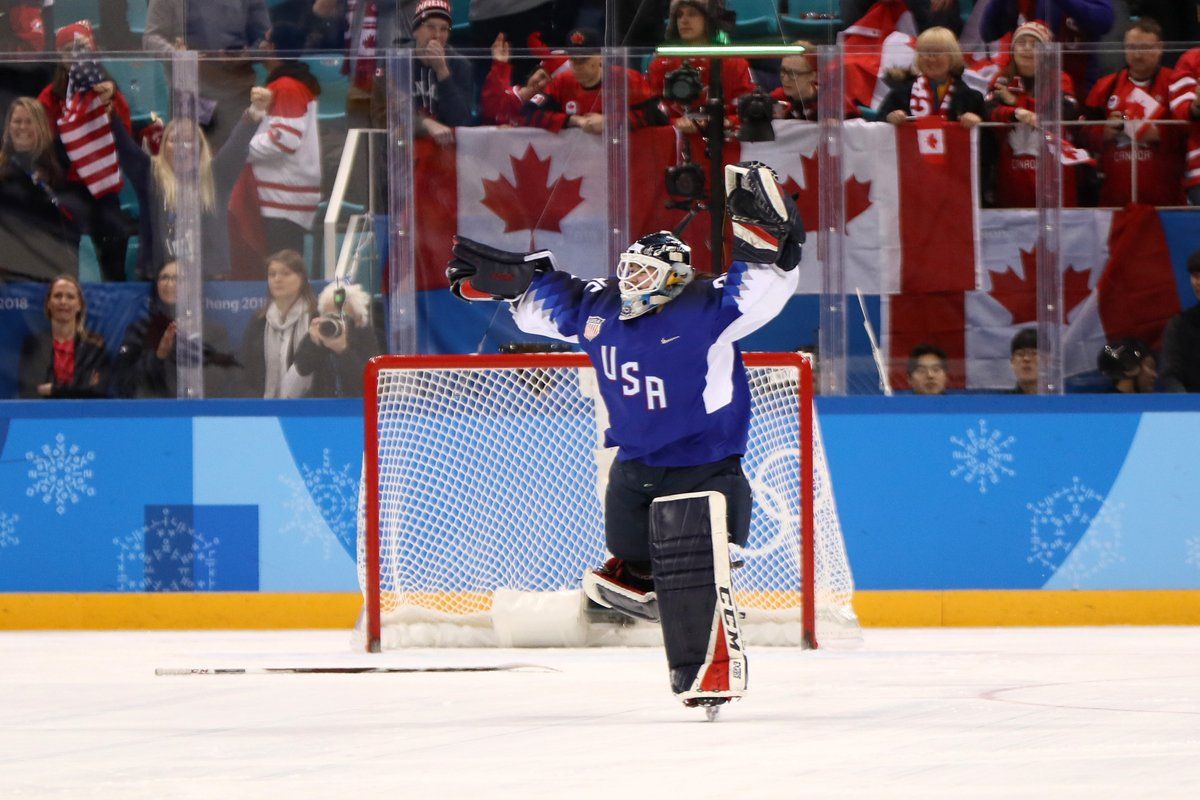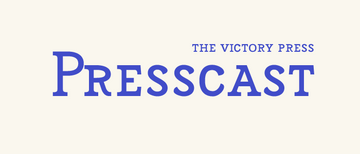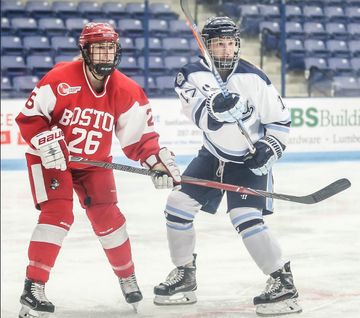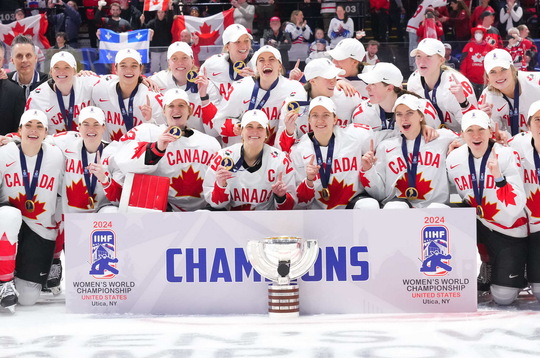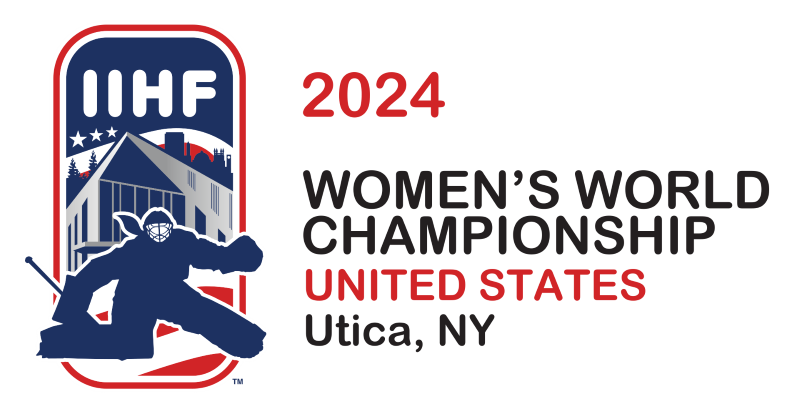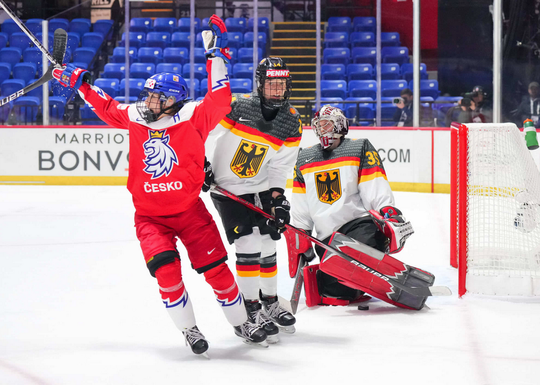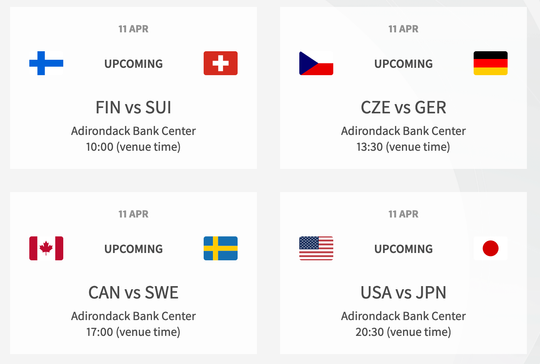Even the most optimistic observer of the US Women's National Team in the gold medal game last night against Canada was probably realizing by the end of the second period that the Americans were not going to win this game 5-on-5...
...or even 5-on-4. Despite an early power play goal by Hilary Knight -- a deflection that left Shannon Szabados with no chance -- the United States failed to score on five subsequent power play chances. Eventually, the penalties called against Canada began to take a kind of grim edge -- you had a feeling that they wouldn't end up being much of an advantage.
It seemed clear that the team wasn't communicating well with each other, missing passes, committing giveaways, and generally not seeing the ice well or finding their teammates well. It was also clear that they were being outcoached. Coach Robb Stauber didn't seem to be making any adjustments or shuffles to combat the chokehold that Canada was placing on their transition game. The line of Monique and Jocelyne Lamoureux and Kelly Pannek was the best on the ice and was arguably under-utilized. Defender Megan Keller spent pretty much every shift she was out there getting obliterated by Canadian forecheckers -- and yet she led Team USA in ice time. Gigi Marvin and Meghan Duggan were held to extremely limited minutes. Haley Skarupa only played 47 seconds, and not at all in the third period or overtime.
Haley Irwin tied the game for Canada early in the second period, directing the puck past Maddie Rooney after a rush was created by Blayre Turnbull. Canada took the lead less than five minutes later after Meghan Agosta connected with none other than Marie-Philip Poulin, who sniped a perfect shot to beat Rooney.
The rest of the second period was more of the same, with the teams trading power play chances. The third almost felt like a foregone conclusion, as Team USA failed to muster much sustained pressure on Shannon Szabados.
But, anything can happen in one game. Kelly Pannek saw Monique Lamoureux-Morando on the far blueline and hit her with a pass that sprung her perfectly, onside, all alone on a breakaway. Emily Pfalzer had been back to disrupt a shot by Laura Stacey, and the puck ricocheted up to the benches. Instead of going for a change with her line, Lamoureux saw her opportunity after a bad change by Canada. She only needed one quick move to beat Szabados on the glove side, and the game was tied.
Everything changed after that. Team USA looked awake. It was the one serious mistake that Team Canada made in the period, and Lamoureux made them pay.
Despite a late penalty on Emily Clark, the game would head to 20 minutes of 4-on-4 overtime, and suddenly, the Americans were an entirely different team. It wasn't just the open ice, though that was part of it. It seemed like the 4-player combination transformed their style of play completely. They were finding passing lanes, backchecking brilliantly, stripping the puck from Canadian forwards on the rush and turning play the other way.
Despite the mere 9-7 shot advantage that Team USA held in overtime, the ice felt tilted. Maddie Rooney made every save she had to make in the extra frame, but so did Szabados. And so the game went to a shootout, per IIHF rules.
Team USA elected to shoot second, and Maddie Rooney opened the shootout with a big save. Gigi Marvin gave the Americans the advantage by beating Szabados, but Meghan Agosta scored on a beautiful move. Hannah Brandt, Poulin, and Pfalzer were all stopped. Melodie Daoust pulled the "Forsberg move" to great effect, luring Rooney out of her net and pushing the puck into a yawning cage. Amanda Kessel immediately evened things up. After Rooney stopped Brianne Jenner, Hilary Knight had a chance to win it for the USA, but she was stopped too.
In the sixth round, the Americans had a chance to choose if they would shoot first or second again, and they chose to shoot first. Jocelyne Lamoureux-Davidson was tapped to take the shot. She whipped out an absolutely ridiculous triple-deke move -- Szabados bit on the fake, and she had plenty of net to slide the puck into. She didn't miss.
Meghan Agosta was given the chance to keep the game going (shooters can repeat indefinitely after five rounds in the IIHF rules), but Rooney made the gold-medal-winning save. The puck stopped in the blue paint at her pads, and Rooney made sure to push it all the way out with her glove before rushing to celebrate with her teammates.
The controversy about USA Hockey's handling of this team is going to linger, despite the win -- and it should. The gold medal is a testament to the talent and teamwork of the players on the ice, but not to Team USA's strategy in developing or supporting the women's game. Less than a year ago, USA Hockey was holding firm in opposition to the demands of its players to be given more financial and developmental support by their governing body. They only relented when it became apparent that nearly every women's hockey player in the country would refuse to play for them and cause them to utterly embarrass themselves at the IIHF Women's Worlds, which could have had a severe impact on their IIHF ranking in the near future and beyond.
Team USA's track record, to be clear, is not exactly stellar with its men's program either, which has had the lion's share of financial resources for many years now. Players who are touted as the "face" of USA Hockey, such as Auston Matthews, who were developed in the men's NDP, are the exception, rather than the rule, for American elite players. The coaching and general managing decisions made by USA Hockey at the senior men's level have been generally amusing, and that's a kind word. Roster choices in the 2014 Olympics, even with NHL players, were embarrassing, as skilled players were notably excluded at many positions, and the team finished 4th.
In this case, the women's national team triumphed despite the fact that they left many of their best players at home or, in fact, did not even invite them to camp. Blake Bolden (who hasn't been included with the senior team for years now, despite attending several developmental camps), Megan Bozek, and Alex Carpenter were notable exclusions. Some roster exclusions may have been made for internal reasons that we may never understand or hear about publicly or on the record, and obviously, the roster that was sent was ultimately successful. Let's put that aside, and focus on what actually happened.
They also triumphed despite the fact that they played 60 minutes of lackluster and disorganized hockey in a championship game -- the biggest game of their lives. The overtime period was extremely redemptive for the team as a whole, but ultimately, a few individual performances pushed them over the edge. That isn't to say that this was not a good team that did not have the potential to win this gold medal. It was a great team, and many players have spoken earnestly about the team camaraderie and how united they felt as a group. But that unity did not translate to on-ice performance in many of their recent games against Canada -- not until Monique Lamoureux's breakaway goal and the shift to 4-on-4 play in OT did Team USA fall back to being the team they had been at the beginning of their exhibition tour and at last year's Worlds.
The shift in the team's on-ice demeanor could be attributed to something ephemeral or mental, but I think astute observers will boil it down to coaching decisions. Robb Stauber said all the right things at Worlds last year about what he wanted this team to be, but the choices he made in terms of deploying players and systemically adjusting to Team Canada were suspect at best and could have been disastrous if it weren't, literally, for Monique Lamoureux and Kelly Pannek making a great play.
In addition, the onus is now on USA Hockey to begin to take themselves seriously as a global leader in hockey development from a perspective of inclusiveness. Thus far, they have abjectly failed to do this. Hockey Canada has been better in some respects, but they also need to improve. To be clear:
- Both of these national governing bodies need to have clear and inclusive policies around gender diversity that focus on self-identification for transgender and nonbinary youth. Check out The Victory Press's three-part series on gender policies by national governing bodies and the IOC. Hockey Canada has no transgender inclusion policy. USA Hockey did not respond to our requests for comment about transgender inclusion policies.
- USA Hockey, in particular, needs to focus on developmental programs for young girls that encourage girls of color to participate, and in fact, must actively create paths for girls of color to play hockey and get serious looks from the U18 and senior developmental programs.
- USA Hockey needs to not only make good on its promises to the US Women's National Team to support the next generation, but to exceed their expectations by creating a truly robust developmental system for all of its athletes that encourages diversity and is looking to a future of hockey that is safer, more supportive, and values skilled players. They must reallocate their resources to equally support all hockey players in both their men's and women's programs.
The world is watching. This gold medal win doesn't mean that USA Hockey has done everything it needs to do for the sport. It's a process that must be ongoing.
(Photo: USA Hockey/Twitter)
